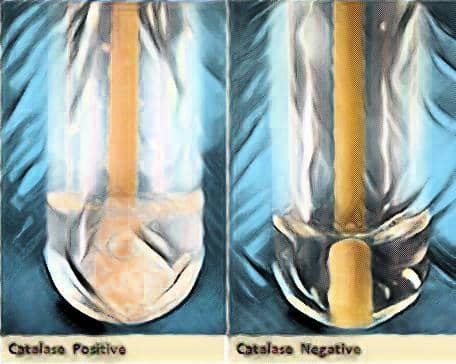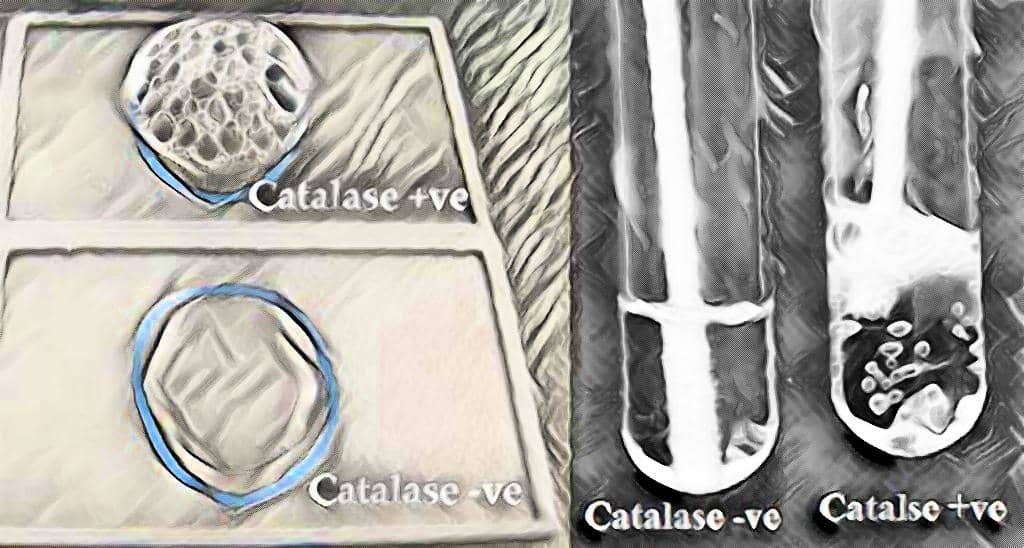Catalase Test – Principle, Procedure, Results, Uses & Precautions
Hey, Good to see you here 😀 …… In this Article, we’re gonna discuss the Principle, Procedure, Uses, and Results of Catalase Test ….. If you have any queries, don’t forget to mention in Comments…
What is Catalase?
Catalase is one of the most common enzymes found in almost all the living organisms that need oxygen to survive (such as bacteria, plants, and animals).
[wp-svg-icons icon=”point-right” wrap=”i”] This enzyme basically catalyzes the decomposition of hydrogen peroxide (H2O2) to water and oxygen molecules.
[wp-svg-icons icon=”point-right” wrap=”i”] Catalase is an essential enzyme in protecting the living cell from oxidative damage which usually caused by reactive oxygen species (ROS).
What is Catalase Test?
Catalase test is one of the three most important tests used for the identification and differentiation of bacterial species in the microbiology laboratory.
[wp-svg-icons icon=”point-right” wrap=”i”] Catalase Enzyme is naturally produced by microorganisms that live in oxygen-rich environments (Aerobic Microbes) to neutralize the harmful forms of oxygen metabolites i.e. H2O2.
[wp-svg-icons icon=”point-right” wrap=”i”] This enzyme counter affects the bactericidal action of hydrogen peroxide (H2O2) and protects them.
[wp-svg-icons icon=”point-right” wrap=”i”] Anaerobic & Facultative Anaerobic microbes which only ferments and do not respire using oxygen (for e.g. Streptococci) generally lack this enzyme and are Catalase test Negative.
The principle of Catalase Test
[wp-svg-icons icon=”point-right” wrap=”i”] As we already discussed, Catalase Enzyme mediates the breakdown of hydrogen peroxide (H2O2) into oxygen and water. This reaction is the basis of Catalase test.
[wp-svg-icons icon=”point-right” wrap=”i”] To check out whether the isolated bacteria or microbe produces Catalase Enzyme, a small portion of isolated bacterial colonies is mixed into hydrogen peroxide solution (usually 3% H2O2) and is carefully observed for the rapid elaboration of oxygen bubbles in the mixture.
[wp-svg-icons icon=”point-right” wrap=”i”] The bubbling is due to the release of Oxygen gas into the mixture which indicates that the organism is able to produce Catalase enzyme and the catalytic action of the enzyme on H2O2 is completed.
[wp-svg-icons icon=”point-right” wrap=”i”] In another case, if the microbe is unable to produce Catalase Enzyme, the reaction is incomplete and no bubbling is observed.
[wp-svg-icons icon=”point-right” wrap=”i”] Sometimes In Facultative Anaerobic Organisms, the production of oxygen bubbles is weak, these organisms are called Weak Catalase Positive.
[penci_related_posts dis_pview=”yes” dis_pdate=”yes” title=”You May Also Like!” background=”” border=”” thumbright=”no” number=”3″ style=”grid” align=”right” withids=”” displayby=”cat” orderby=”rand”]What is the Various Concentration of Hydrogen Peroxide (H2O2) used in Catalase test?
[wp-svg-icons icon=”point-right” wrap=”i”] Most Commonly 3% hydrogen peroxide (H2O2) Solution is used in routine testing and identification of Aerobes.
[wp-svg-icons icon=”point-right” wrap=”i”] For the identification & Differentiation of Anaerobic bacteria, 15% Hydrogen Peroxide (H2O2) solution is used in Catalase test.
[wp-svg-icons icon=”point-right” wrap=”i”] The Superoxol test is another modification of the Catalase test in which 30% Hydrogen Peroxide (H2O2) solution is used for the identification of Catalase positive organism and commonly used for Neisseria
What are the Uses of Catalase Test?
[wp-svg-icons icon=”point-right” wrap=”i”] Catalase test is most commonly used to distinguish the genus and species of Gram-positive cocci (Round shape bacteria. For E.g. – the Staphylococcuslike species are Catalase Positive whereas the other GPC bacteria like Streptococcus and Enterococcus are Catalase negative.
[wp-svg-icons icon=”point-right” wrap=”i”] Catalase test is also commonly used to differentiate the Aerotolerant strains of Clostridium (Catalase negative) from Bacillus species (Catalase positive).
[wp-svg-icons icon=”point-right” wrap=”i”] A rapid Semi-quantitative Catalase test is used for the identification of M. tuberculosis.
[wp-svg-icons icon=”point-right” wrap=”i”] Catalase test can also be used for the identification of the members of the Enterobacteriaceae family. Some of the members of Enterobacteriaceae are Catalase positive.
Now I am gonna explain two methods that are commonly used for the Catalase test in the Laboratory. You can use any of the methods as per your convenience….
The Procedure of Catalase test (Slide Method)
[wp-svg-icons icon=”point-right” wrap=”i”] Take a clean, dry and grease free microscopic glass slide and place a drop of 3% H2O2 onto the slide.
Note: At one time you can easily perform Catalase test of 2 or 3 specimens on a single slide so divide the space accordingly and Place the H2O2 drop in the center of the divided portions of the slide.
[wp-svg-icons icon=”point-right” wrap=”i”] Now, transfer a portion of the isolated bacterial colony to the drop of hydrogen peroxide on to the glass slide using a sterile inoculating stick.

[wp-svg-icons icon=”point-right” wrap=”i”] Mix well the specimen and H2O2 drop on the slide.
[wp-svg-icons icon=”point-right” wrap=”i”] Carefully observe for the evolution of Bubbled in the mixture on the Glass slide.
The Procedure of Catalase Test (Tube Method)
[wp-svg-icons icon=”point-right” wrap=”i”] Take a Clean, Dry and sterilized Laboratory test tube and add 5-7 drops of hydrogen peroxide (H2O2) Solution in it.
[wp-svg-icons icon=”point-right” wrap=”i”] Now, pick a small portion of the isolated bacterial colony using a sterile wooden applicator stick and carefully place it into the test tube.

[wp-svg-icons icon=”point-right” wrap=”i”] Finally, observe the tube against a dark background for immediate bubble formation at the end of the wooden stick in the test tube.
Results of the Catalase test
Observe the reaction mixtures carefully for the formation of bubbles or effervescence.
[wp-svg-icons icon=”point-right” wrap=”i”] The reaction mixture (whether on a Slide or in a test tube) in which the immediate (within 5-10 seconds) bubble formation is observed is the Catalase Positive reaction and the microbe is reported as Catalase Positive.
Catalase Positive from Darryl Nelson on Vimeo.
[wp-svg-icons icon=”point-right” wrap=”i”] On the other hand, if there is no bubble formation or delayed (after 20-30 seconds) few bubbles are formed, the reaction is termed as Catalase Negative Reaction and the microbe is reported as Catalase Negative.
Precautions to be taken while Performing Catalase Test
[wp-svg-icons icon=”point-right” wrap=”i”] For the Catalase test, do not use the metallic needle or loop (inoculating loop) because metals can react with Hydrogen peroxide and may give you the false positive results of the reaction.
[wp-svg-icons icon=”point-right” wrap=”i”] Another thing is that be very careful if you are picking up the isolated colonies from the blood agar as the red cells present in the blood agar medium are Catalase positive and may give the false positive results.
[wp-svg-icons icon=”point-right” wrap=”i”] Also, there are certain bacteria which possess many enzymes besides that of Catalase and are able to decompose the hydrogen peroxide into oxygen and water similarly to that of Catalase but these reactions are usually time taken and the bubbles of oxygen are usually produced after 30 seconds so carefully observe the reaction and precisely note the time of reaction unless you may get false positive results.
[wp-svg-icons icon=”point-right” wrap=”i”] Dispose of your test slides and inoculating stick/loops in the respective biohazard disposal containers as per the norms.
Various Catalase positive and Catalase Negative Bacteria
Catalase Positive Organisms – Staphylococcus sp., Micrococcus sp., Listeria sp., Corynebacterium diphtheriae, Burkholderia cepacia, Nocardia sp., Citrobacter sp., Escherichia coli, Klebsiella sp., Yersinia sp., Shigella sp., Proteus sp., Serratia sp., Pseudomonas sp., Mycobacterium tuberculosis, Aspergillus sp., Cryptococcus sp. etc.
Catalase Negative Organisms – Streptococcus species, Enterococcus species etc.
Frequently Asked Questions (FAQs)
The catalase test is based on the principle that catalase, an enzyme produced by bacteria, can decompose hydrogen peroxide into water and oxygen. The presence of catalase in a bacterial sample can be detected by observing the release of oxygen gas bubbles when hydrogen peroxide is added to the sample.
One precaution of the catalase test is to use a fresh culture of bacteria for testing, as older cultures may have reduced levels of catalase activity. Additionally, care should be taken to prevent contamination of the hydrogen peroxide solution, as any organic material or other contaminants may interfere with the reaction.
The principle of determining catalase activity involves measuring the rate of oxygen release as hydrogen peroxide is decomposed by catalase. The procedure typically involves adding hydrogen peroxide to a bacterial sample, and observing the rate and amount of oxygen gas bubbles released over time.
Catalase is widely used in a variety of industries, including food processing, textiles, and pharmaceuticals. It is also used in research to study the function and activity of enzymes, and in medical applications to diagnose and treat diseases related to catalase deficiency.
The basic principle for measuring enzyme activity is to monitor the rate of a specific biochemical reaction catalyzed by the enzyme of interest. This can be done by measuring changes in the concentration of substrate or product over time, or by monitoring other physical or chemical changes that occur during the reaction.
The general principle of enzyme catalysis is that enzymes are able to accelerate the rate of chemical reactions by lowering the activation energy required for the reaction to occur. Enzymes do this by binding to reactant molecules in a specific orientation, and providing a more favorable environment for the reaction to occur.







